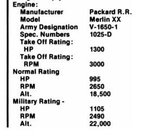Shortround6
Lieutenant General
In other words, it took 2 years, plus WEP for Allison to almost equals the performance of R-2600 of 1940/41? I rest my case
Except that the Allison was several hundred pounds lighter, including the radiator, and had about 1/3 the frontal area.
Clear advantage in my eyes - I bet Germans would've ritually sacrifice ms. Eva Braun for availability of a reliable 1500 HP engine for Bf-109s in time of BoB. USA was the only country that had that option available, and they skipped it.
I am sure the Germans would have too. They might have even done it for a good 1500hp bomber engine. The Problem is that the R-2600 as built wouldn't have done much for the altitude performance of the 109.
The diameter of an bare R-2600 is several inches greater than the outside diameter of the cowling of the BMW 801. It is around 600lbs heavier than an early Merlin or an Allison or a DB 601 so even factoring in the weight of radiator and coolant it is around 300lbs heavier. Then you need a heavier propeller and a larger oil tank/oil cooler.
With-out a larger heavier/better supercharger the power of the R-2600 falls off at a lower altitude than the Merlin or DB 601 so performance at 20,000ft is much closer than the take of figures show. An R-2600 that developed 1700hp for take off was using 44.5in of boost or 1.48 atmo of pressure. it was also using low gear in it's supercharger which took about half the power of high gear to drive.
The US may have had reason to skip the option.




